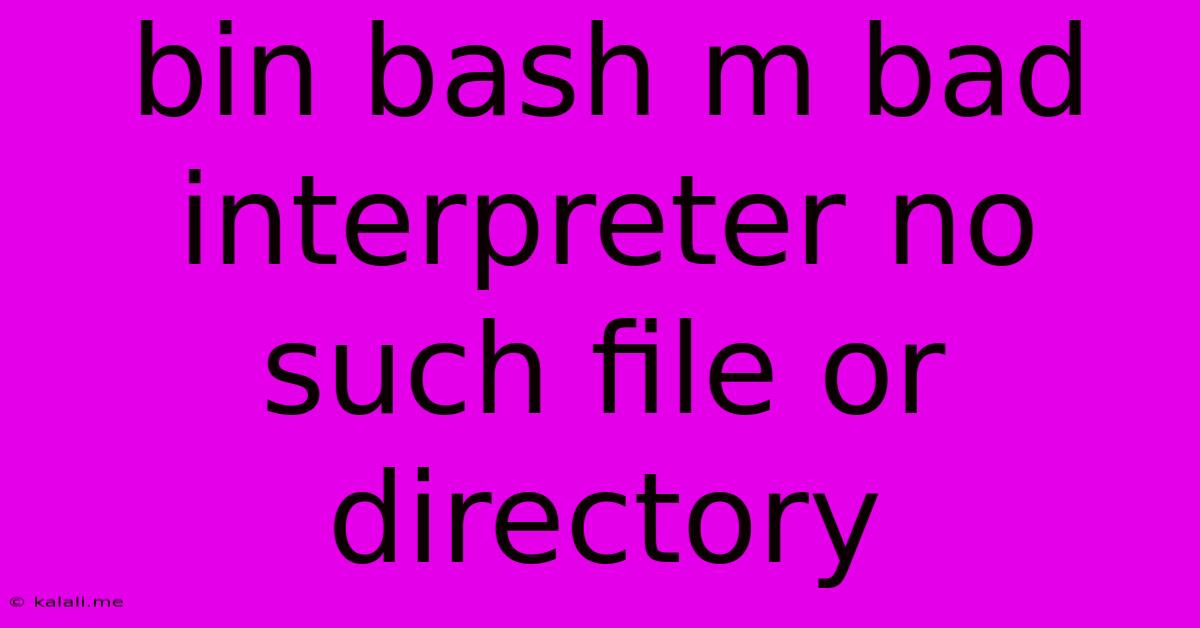Bin Bash M Bad Interpreter No Such File Or Directory
Kalali
May 21, 2025 · 4 min read

Table of Contents
"bin/bash: /bin/bash: bad interpreter: No such file or directory": Troubleshooting and Solutions
Encountering the error message "bin/bash: /bin/bash: bad interpreter: No such file or directory" can be frustrating, especially for users comfortable with the command line. This error typically indicates a problem with the shebang line in your script or a more fundamental issue with your system's environment. This article will delve into the root causes of this error and provide practical solutions to get you back on track.
What causes this error?
This error usually means the system can't find the Bash interpreter, specified by #!/bin/bash at the beginning of your script. This can stem from several reasons:
- Incorrect Shebang: The most common cause is a wrongly written or misplaced shebang line. A simple typo or incorrect path can lead to this error. The shebang must accurately point to the location of the Bash interpreter on your system.
- Missing Bash Interpreter: Less common, but possible, is that the Bash interpreter itself (
/bin/bash) might be missing or corrupted on your system. This is usually due to a system corruption or a failed software installation. - Incorrect Permissions: Your script file may lack the necessary execute permissions. The system needs to be allowed to run it.
- Symbolic Links: Problems with symbolic links pointing to the Bash interpreter can also cause this. A broken or incorrectly configured symbolic link will prevent the system from finding the executable.
- Environment Variables: Rarely, issues with crucial environment variables can indirectly cause this error. This is less frequent but still possible.
Troubleshooting Steps and Solutions
Let's tackle these problems step-by-step:
1. Verify the Shebang Line:
- Location: The shebang line (
#!/bin/bash) must be the very first line of your script file. Any whitespace or comments before it will cause problems. - Accuracy: Double-check the path
/bin/bash. While usually correct, in some non-standard setups, Bash might reside elsewhere (e.g.,/usr/bin/bash). Use thewhich bashcommand in your terminal to confirm the correct path on your system. If it differs, update the shebang accordingly.
2. Check File Permissions:
Use the chmod command to ensure your script has execute permissions:
chmod +x your_script_name.sh
Replace your_script_name.sh with the actual name of your script file.
3. Check for a Corrupted or Missing Bash Interpreter:
This is less common but possible. If the which bash command doesn't return a path, or if you suspect Bash corruption, you might need to reinstall it. The exact method depends on your operating system (e.g., using your distribution's package manager like apt on Debian/Ubuntu or yum on Fedora/CentOS/RHEL). Consult your system's documentation for the correct procedure.
4. Examine Symbolic Links:
If you suspect symbolic link issues, try locating the Bash interpreter using find / -name bash 2>/dev/null (the 2>/dev/null suppresses error messages). This command searches your entire file system. If you find it in an unexpected location, investigate why it's not in the standard /bin or /usr/bin directories.
5. Investigate Environment Variables (Advanced):
Issues with environment variables are less frequent causes. If the above steps don't resolve the problem, you might need to check your environment variables, focusing on those related to the PATH variable, which determines where the system looks for executables. This is a more advanced troubleshooting step and may require deeper system knowledge.
Preventing Future Errors:
- Use a Text Editor: Avoid using word processors (like Microsoft Word) to create shell scripts. Use a plain text editor (like vim, nano, or Notepad++) to prevent unexpected formatting issues.
- Always Test: Test your scripts thoroughly after making any changes. Start with small, manageable sections and gradually build up complexity.
- Use Absolute Paths (When Necessary): In some cases, especially when scripts are used in different contexts or environments, using absolute paths (e.g.,
/usr/bin/env bash) in your shebang can help resolve ambiguity.
By carefully following these steps, you should be able to diagnose and resolve the "bin/bash: /bin/bash: bad interpreter: No such file or directory" error and get your scripts running smoothly. Remember to consult your system's documentation if you encounter any unexpected complications.
Latest Posts
Latest Posts
-
If Your 35 What Year Was You Born
Jul 12, 2025
-
How Many Cups Is 1 Pound Of Cheese
Jul 12, 2025
-
30 X 30 Is How Many Square Feet
Jul 12, 2025
-
How Much Does A Half Oz Weigh
Jul 12, 2025
-
Calories In An Omelette With 3 Eggs
Jul 12, 2025
Related Post
Thank you for visiting our website which covers about Bin Bash M Bad Interpreter No Such File Or Directory . We hope the information provided has been useful to you. Feel free to contact us if you have any questions or need further assistance. See you next time and don't miss to bookmark.